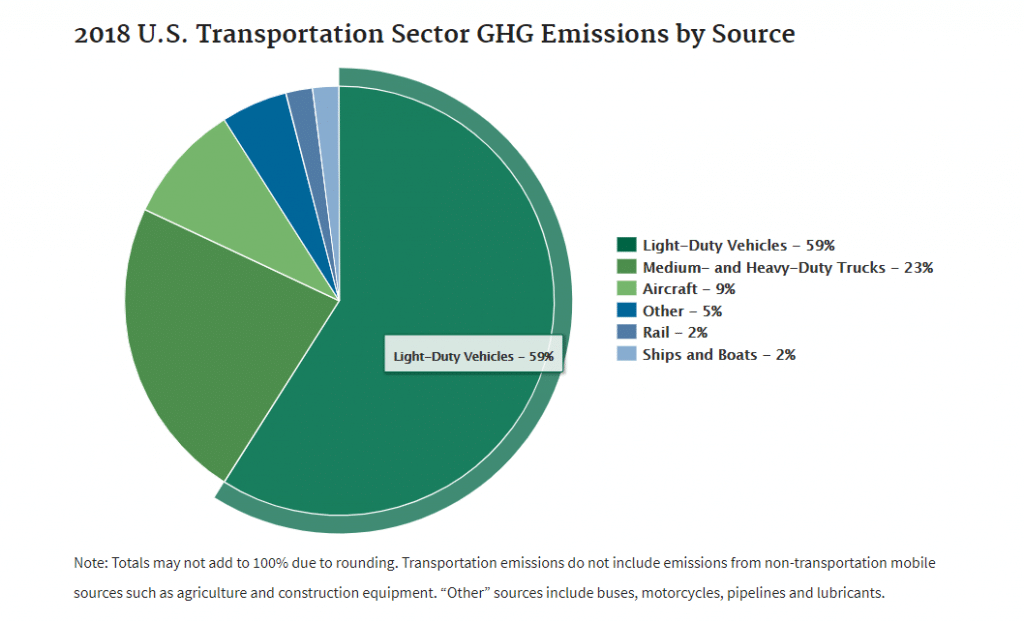April 22, 2021
Happy Earth Day 2021! Earth Day started in 1970 as a day to focus on the effects of human activity on the planet. While the topics of interest and action have shifted over the years, this year’s theme is “Restore Our Earth,” which includes a focus on climate change. The combustion of fossil fuels, primarily through human actions, has increased the concentration of greenhouse gases in our atmosphere, which has accelerated the overall warming of the planet. To address climate change, we must solve multiple challenges, including reducing greenhouse gas emissions and enhancing resiliency to prepare for the changes we are already facing. There’s good news—we have solutions: greater deployment of renewable energy sources, deployment of zero-emission transportation, and upgrading infrastructure can help reduce the causes and impacts of climate change.
The transportation sector is the leading source of greenhouse gas emissions in the United States, accounting for 28% of emissions. Greenhouse gas emissions are the primary drivers of climate change and cause extreme heat events, more powerful hurricanes, sea level rise, and heavier rainfall. We are already experiencing the impacts of these changes—flooding, wildfires, and accelerated sea ice loss to name a few. As the economy recovers, emissions from the transportation sector are expected to rise, even given the recent decreases in travel caused by the COVID pandemic. Aggressive actions must be taken today to avoid the costly impacts of climate change by cutting emissions and ensuring that our transportation infrastructure is resilient to the impacts we are already experiencing.
While you might assume that the bulk of transportation emissions come from heavy-duty vehicles, aircraft, or other modes of transportation, it’s actually the everyday sedans and SUVs that account for the most transportation-related emissions – 59%.

Transportation climate solutions are here today, and the integration of technology is an essential component of how we will address transportation emissions. At the Intelligent Transportation Society of America (ITS America), we are thinking through those challenges and advocating for solutions that meet the needs of a 21st century transportation system. We recently released “A Better Future Transformed by Intelligent Mobility; ITS America’s Blueprint for a Safer, Greener, Smarter Transportation System.” This blueprint addresses technology deployment and integration for a transportation system that is safe, efficient, reduces greenhouse gas emissions, and is resilient to climate impacts. It is a holistic approach focusing on key issues, including Vehicle-to-Everything and connected transportation, smart infrastructure, mobility on demand, autonomous vehicles, emerging technologies, and sustainability and resiliency. In terms of sustainability and resiliency, we are focused on technologies that will reduce emissions, create a robust network of zero-emission fueling infrastructure, build resilient infrastructure, and develop infrastructure that can support the necessary power generation and grid capacity for widescale electrification.
Electric vehicles and electric vehicle charging are two solutions that are available today. As mentioned above, greater deployment of zero-emission vehicles (electric and green hydrogen), installation of more electric vehicle chargers, and investments in our electric infrastructure will reduce emissions from the transportation sector. These technologies are market-ready, and many manufacturers are making vehicle electrification a priority. General Motors has announced it will stop making gasoline-powered vehicles by 2035, Ford has committed to 100% electric vehicles for its European market by 2030, Volkswagen is planning on launching 70 new electric models by 2030, and Jaguar announced that it will be 100% electric by 2030.
In addition to the release of new EV models, interest in and commitments for EV charger deployment are also increasing. Last month, the Biden Administration announced a goal of building 500,000 EV chargers across the country. In early 2020, ChargePoint announced a $1 billion investment in charging infrastructure in travel plazas and truck stops. The newly formed Electric Highway Coalition, composed of six major utility companies, announced a plan to deploy chargers across the Southeast. Growing networks of charging infrastructure will reduce range anxiety and encourage greater adoption of electric vehicles.
The future is here today. Options and commitments for electrified transportation are growing, the buildout of renewable energy sources is increasing, and the deployment of technologies is improving the efficiency of our vehicles and the resiliency of our infrastructure. As we celebrate Earth Day 2021, let’s continue to focus on working together to build a stronger, smarter, greener transportation system for the 21st century.

Morgan Ellis is the Vice President, Sustainable Transportation at ITS America.
Contact her at mellis@itsa.org

